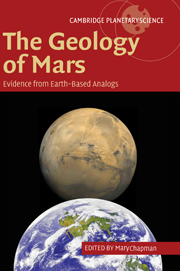Book contents
- Frontmatter
- Contents
- Preface: the rationale for planetary analog studies
- List of contributors
- 1 The geology of Mars: new insights and outstanding questions
- 2 Impact structures on Earth and Mars
- 3 Terrestrial analogs to the calderas of the Tharsis volcanoes on Mars
- 4 Volcanic features of New Mexico analogous to volcanic features on Mars
- 5 Comparison of flood lavas on Earth and Mars
- 6 Rootless volcanic cones in Iceland and on Mars
- 7 Mars interior layered deposits and terrestrial sub-ice volcanoes compared: observations and interpretations of similar geomorphic characteristics
- 8 Lava—sediment interactions on Mars: evidence and consequences
- 9 Eolian dunes and deposits in the western United States as analogs to wind-related features on Mars
- 10 Debris flows in Greenland and on Mars
- 11 Siberian rivers and Martian outflow channels: an analogy
- 12 Formation of valleys and cataclysmic flood channels on Earth and Mars
- 13 Playa environments on Earth: possible analogs for Mars
- 14 Signatures of habitats and life in Earth's high-altitude lakes: clues to Noachian aqueous environments on Mars
- 15 The Canyonlands model for planetary grabens: revised physical basis and implications
- 16 Geochemical analogs and Martian meteorites
- 17 Integrated analog mission design for planetary exploration with humans and robots
- Index
- Plate section
- References
5 - Comparison of flood lavas on Earth and Mars
Published online by Cambridge University Press: 18 September 2009
- Frontmatter
- Contents
- Preface: the rationale for planetary analog studies
- List of contributors
- 1 The geology of Mars: new insights and outstanding questions
- 2 Impact structures on Earth and Mars
- 3 Terrestrial analogs to the calderas of the Tharsis volcanoes on Mars
- 4 Volcanic features of New Mexico analogous to volcanic features on Mars
- 5 Comparison of flood lavas on Earth and Mars
- 6 Rootless volcanic cones in Iceland and on Mars
- 7 Mars interior layered deposits and terrestrial sub-ice volcanoes compared: observations and interpretations of similar geomorphic characteristics
- 8 Lava—sediment interactions on Mars: evidence and consequences
- 9 Eolian dunes and deposits in the western United States as analogs to wind-related features on Mars
- 10 Debris flows in Greenland and on Mars
- 11 Siberian rivers and Martian outflow channels: an analogy
- 12 Formation of valleys and cataclysmic flood channels on Earth and Mars
- 13 Playa environments on Earth: possible analogs for Mars
- 14 Signatures of habitats and life in Earth's high-altitude lakes: clues to Noachian aqueous environments on Mars
- 15 The Canyonlands model for planetary grabens: revised physical basis and implications
- 16 Geochemical analogs and Martian meteorites
- 17 Integrated analog mission design for planetary exploration with humans and robots
- Index
- Plate section
- References
Summary
Introduction
Flood lavas, by definition, cover vast areas in great sheets of lava, without the construction of major edifices (e.g., Geikie, 1880; Washington, 1922; Tyrrell, 1937; Self et al., 1997). The flat terrain that flood lavas produce has led to the term “plateau volcanism” to be used as a synonym for flood volcanism. In addition, the classic erosion pattern of flood lavas leaves a series of topographic steps. Thus many flood basalt provinces are known as “traps” from the Scandinavian word for steps. Plateau volcanism transitions to “plains” volcanism when low shields become common (Greeley and King, 1977). It is not surprising that these large-volume eruptions are usually composed of the most common of volcanic rocks: basalt. Thus, the term “flood basalt” is often used interchangeably with “flood volcanism.” However, there can be interesting and significant compositional variability within flood “basalt” provinces. The most general term to describe all large-volume volcanism is “Large Igneous Province” (LIP) (e.g., Coffin and Eldholm, 1994).
LIPs represent a major geologic event with significant repercussions on the interior of a planetary body. The extraction of such large volumes of magma can alter the thermal state of the mantle, indicate major changes in the convection patterns within the mantle, and lead to geochemical evolution of the mantle on a regional scale (e.g., Coffin and Eldholm, 1994 and references therein). Flood lavas also alter the face of a planet for geologically significant time.
- Type
- Chapter
- Information
- The Geology of MarsEvidence from Earth-Based Analogs, pp. 126 - 150Publisher: Cambridge University PressPrint publication year: 2007
References
- 11
- Cited by



